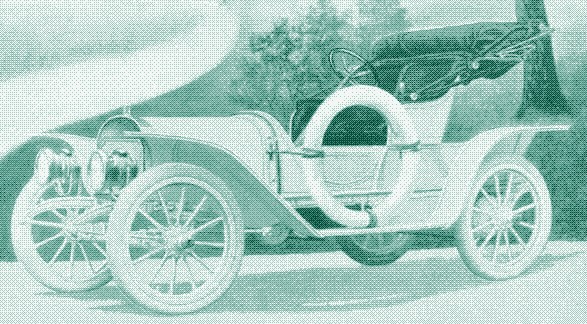
Beaucoup de ces voitures électriques avaient une autonomie comparable à celles des véhicules modernes. Vous trouverez ci-dessous une vue d’ensemble de ces véhicules et de leurs caractéristiques, composée à partir de catalogues de vente.
Catalogue de 1907 (fabricants divers)
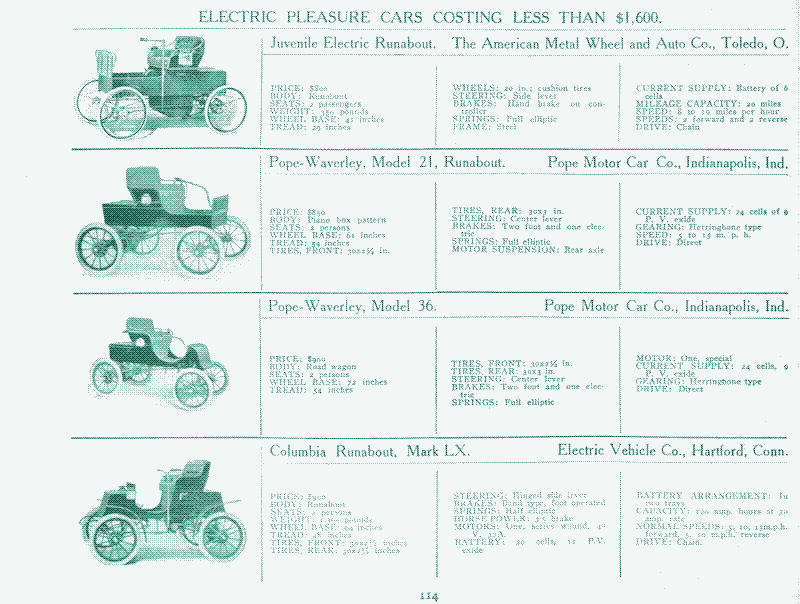
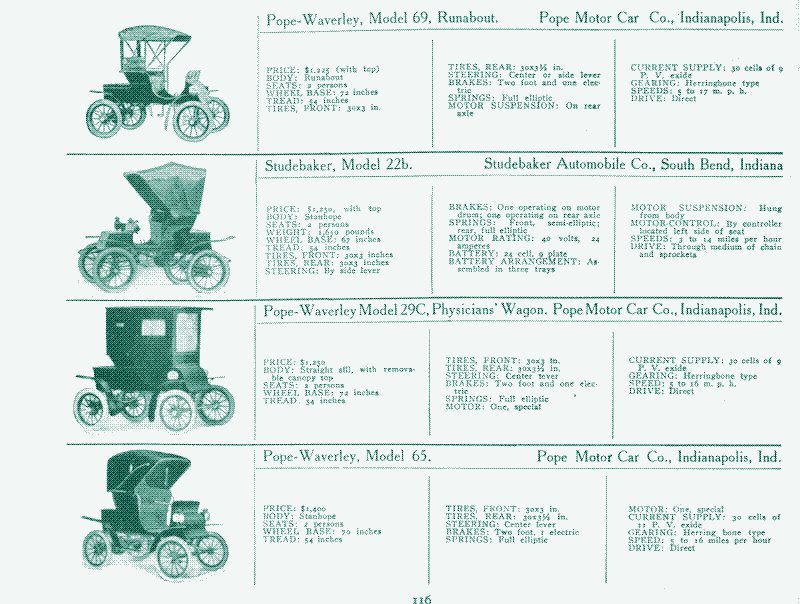
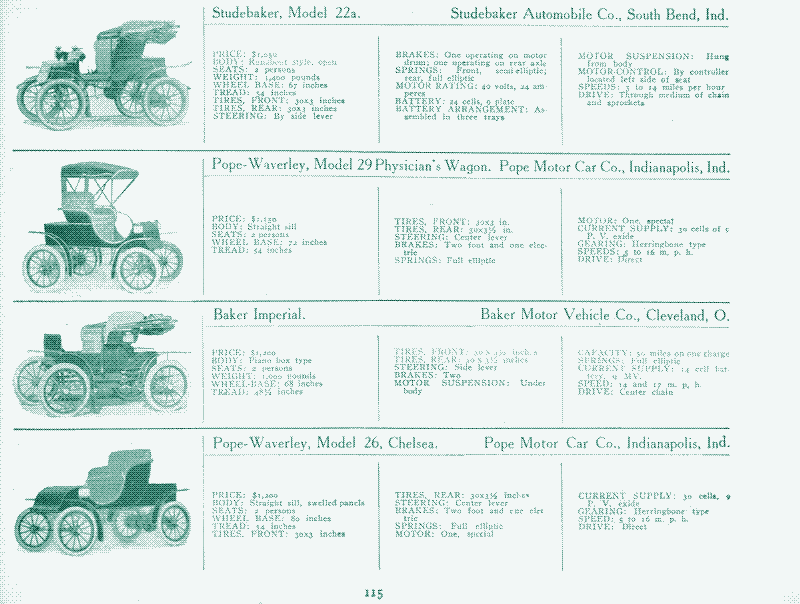
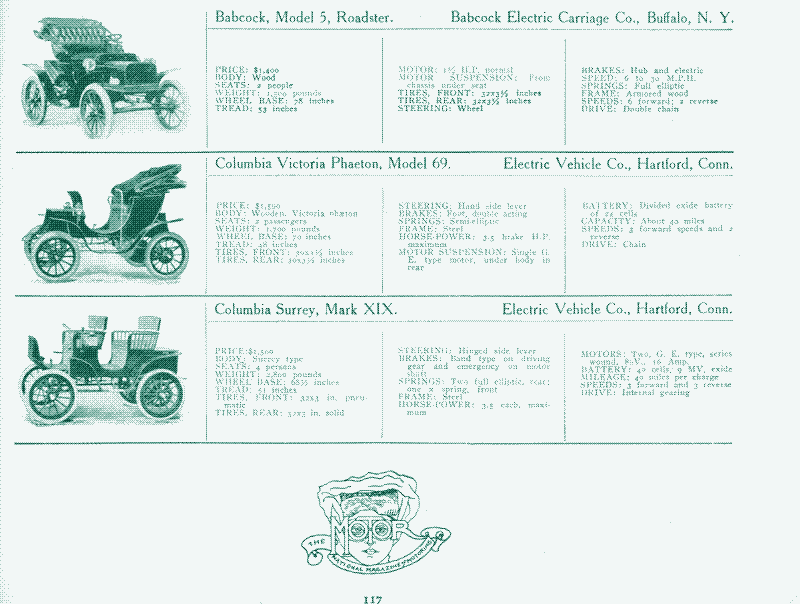
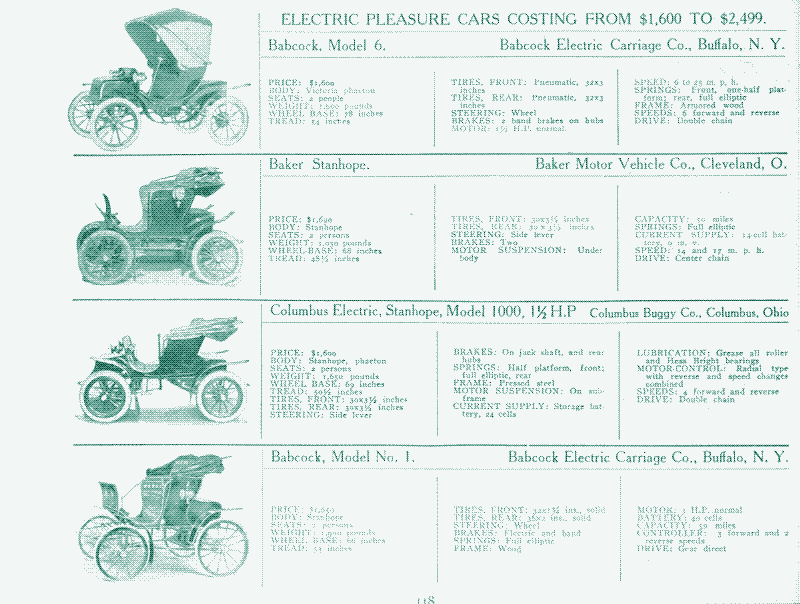
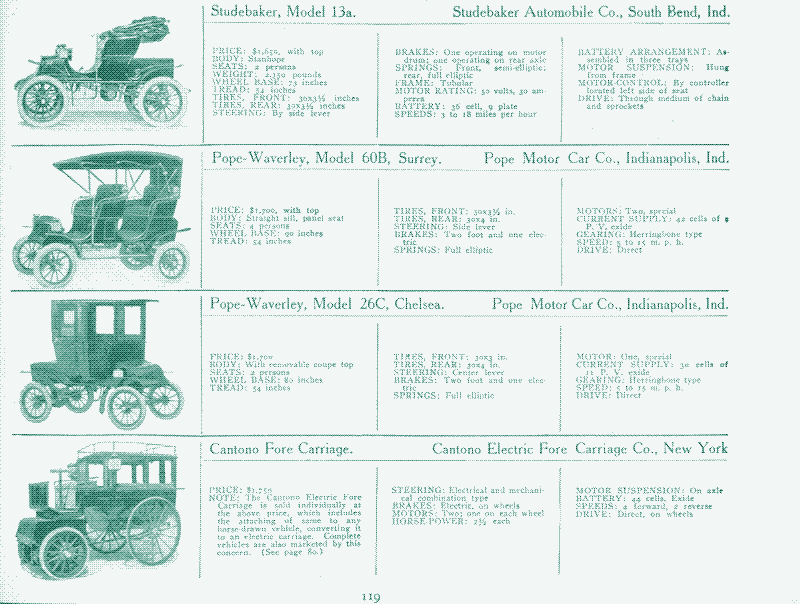
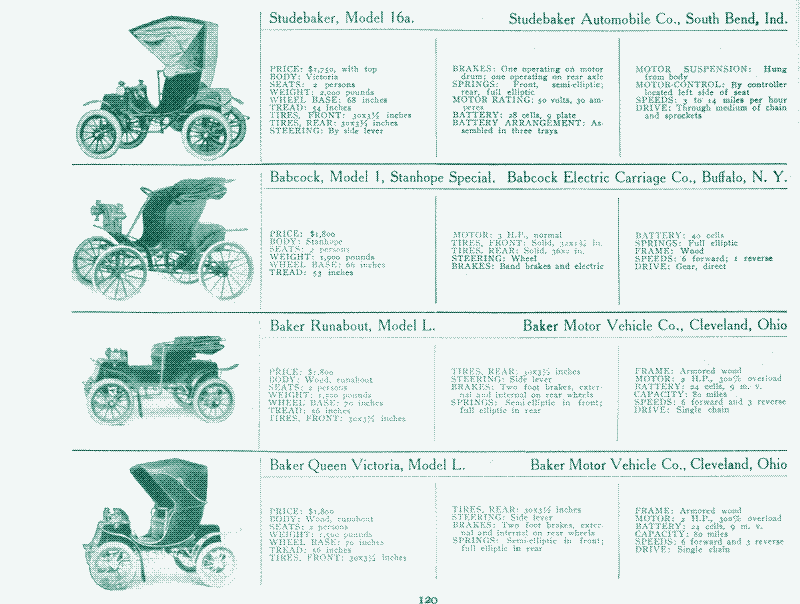
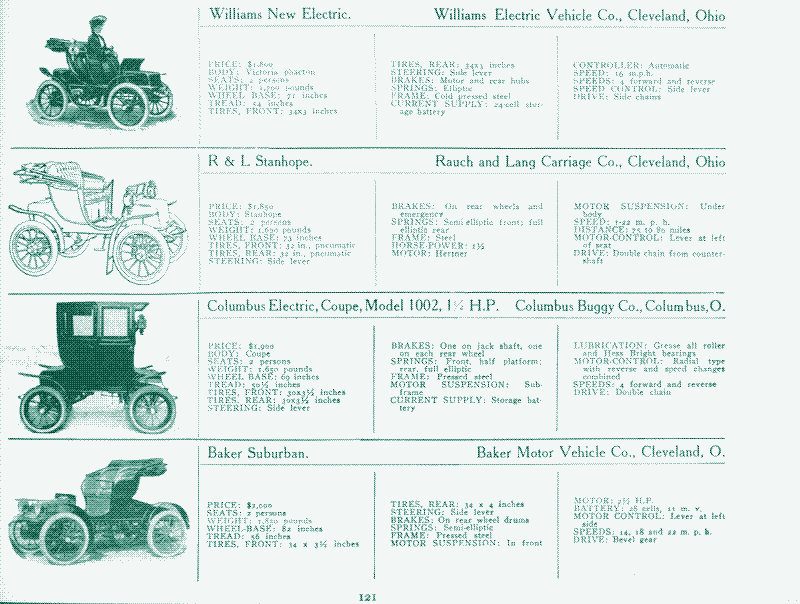
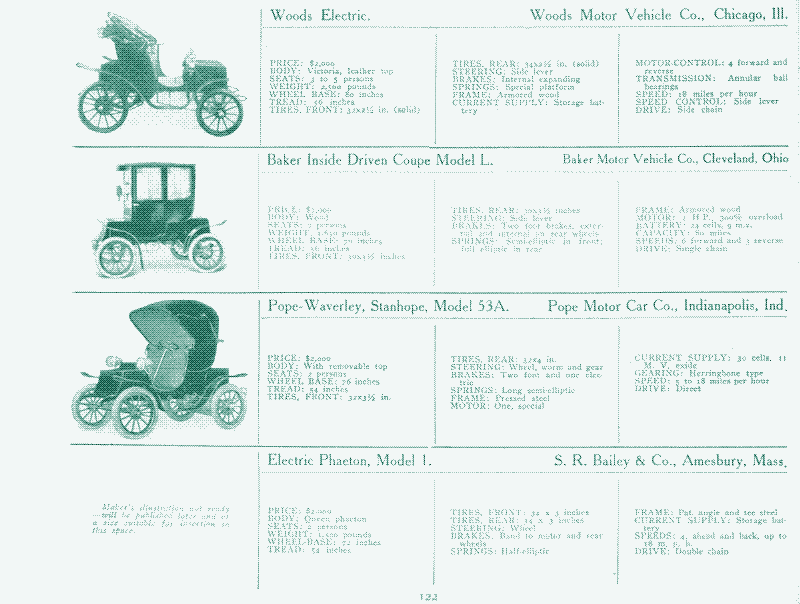
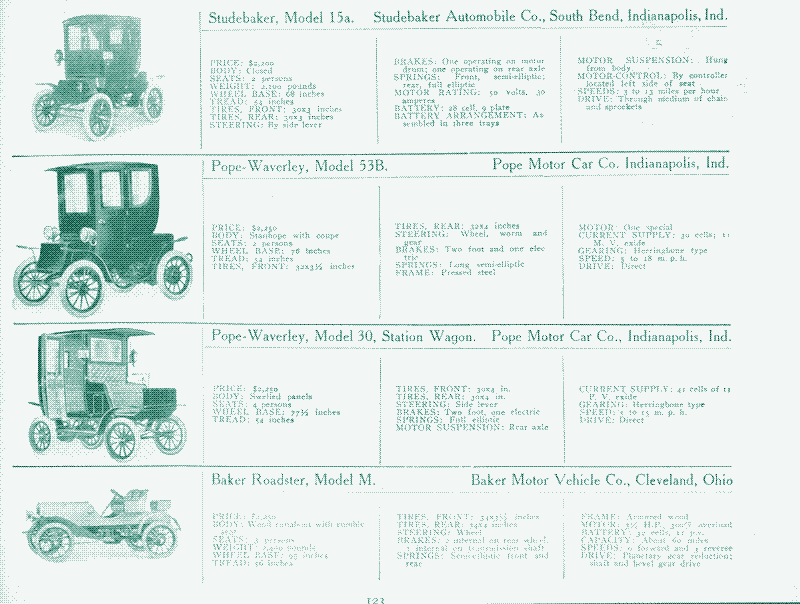
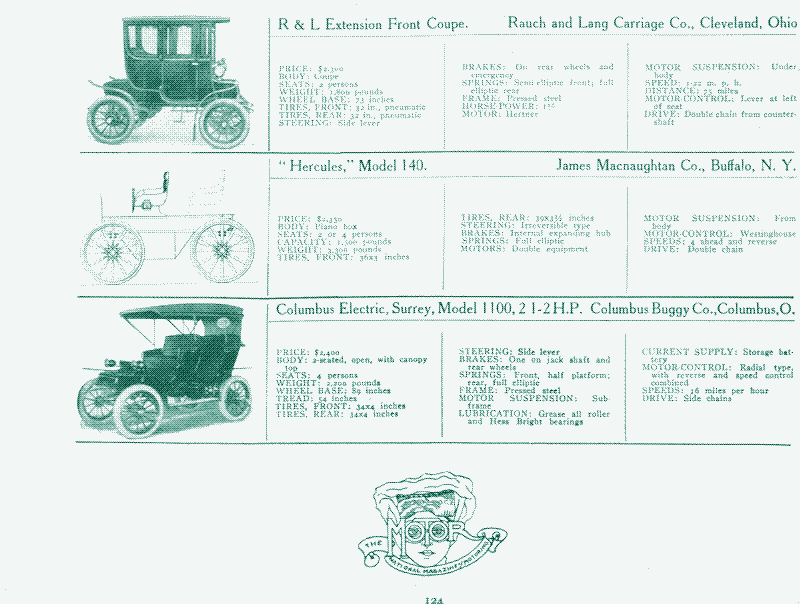
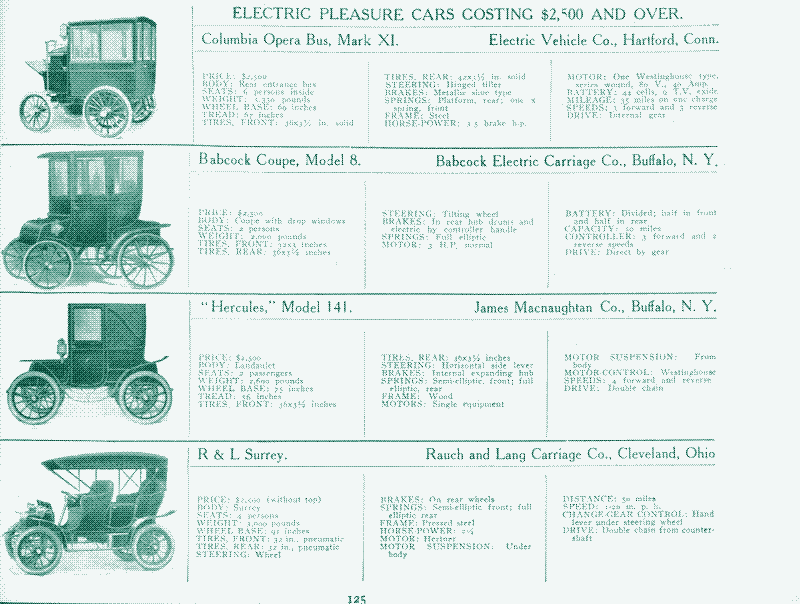
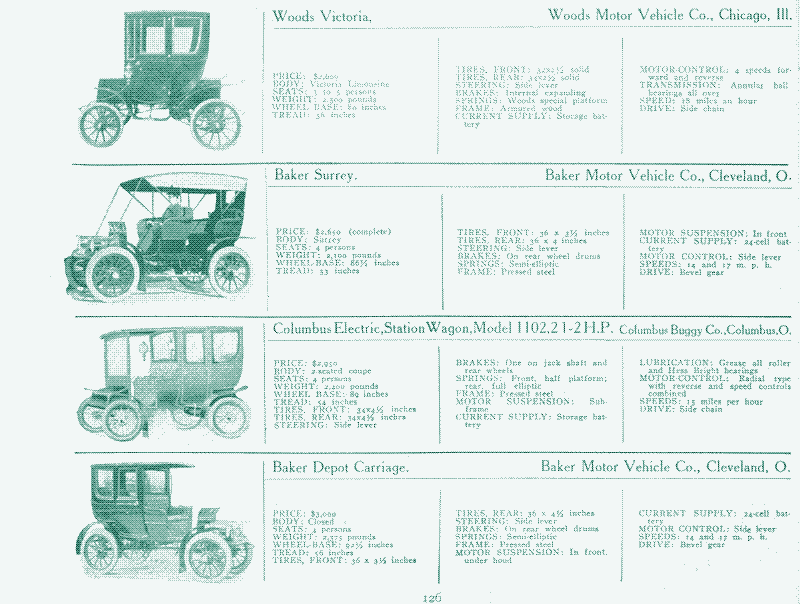
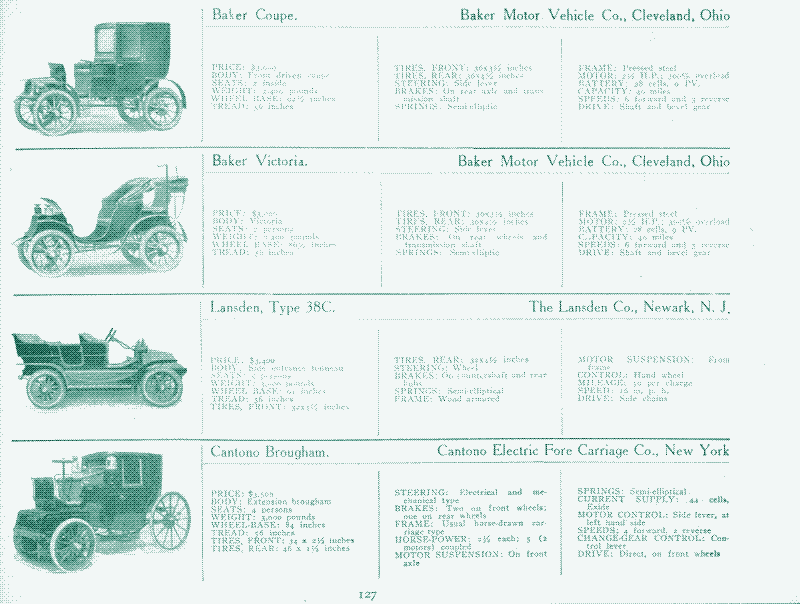
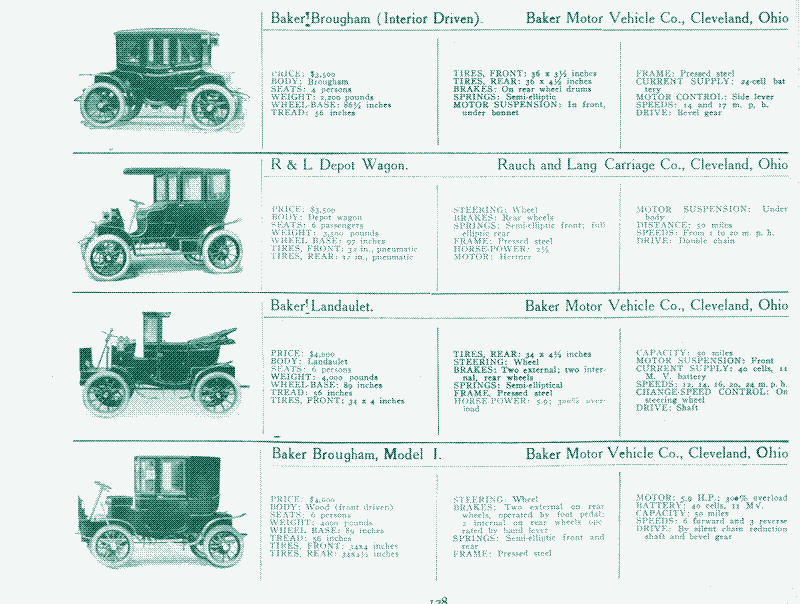
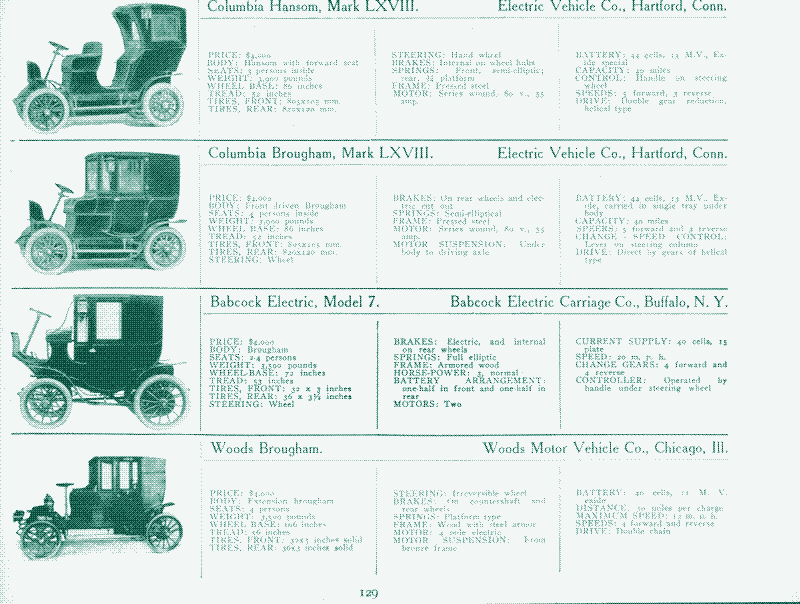
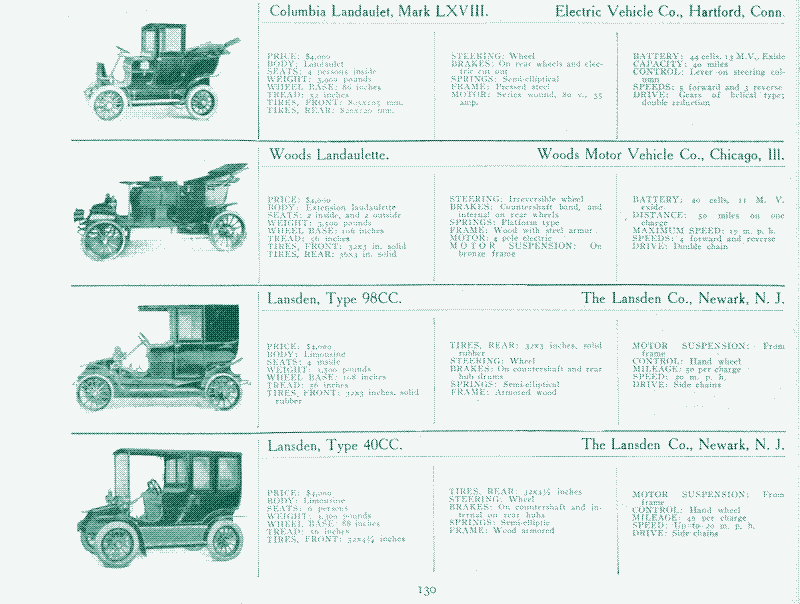
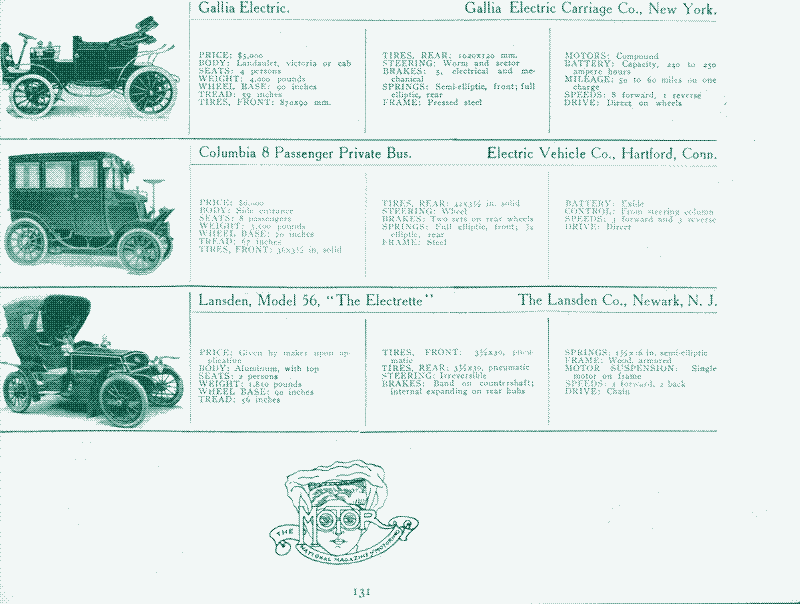
Source : « An illustrated directory of the specifications of all domestic and foreign motor-cars and motor business wagons gasoline, steam, and electric sold in this country », New York, 1907. Vous pouvez également consulter la vue d’ensemble des premiers camions électriques extraite du même catalogue.
Au début du XXe siècle, la dénomination des modèles de voitures était différente et se résumait à la marque, le numéro de modèle et le type de carrosserie. La plupart des carrosseries s’inspiraient de celles utilisées pour les calèches (vue d’ensemble ici).
Véhicules électriques Columbia
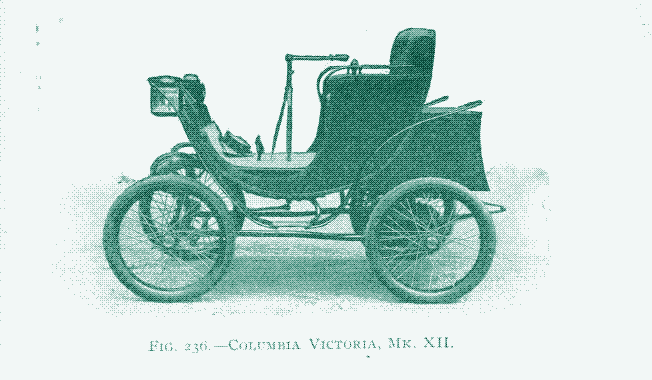
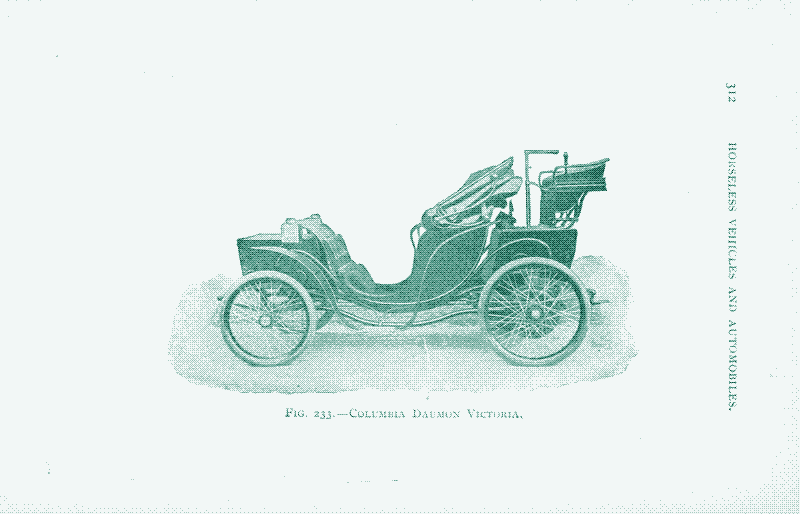
Le Mark III (image) est aujourd’hui considéré comme le véhicule électrique américain « standard ». Il est équipé d’un moteur unique de 25 ampères et a une vitesse de pointe de 19,5 km/h. Sa batterie, composée de 44 cellules au chlore, possède une capacité de 75 ampères-heures (Ah) sur 3 heures, ce qui correspond à une autonomie de 56 km sur route normale. Le poids total du véhicule est de 1,165 tonnes.
Le dog cart, dénommé Mark VI, représente un autre type de véhicule de loisir populaire (image). Ce modèle possède un moteur unique de 30 ampères. Sa batterie, composée de 44 cellules, se décharge en 3 heures et fournit une capacité de 90 Ah pour une autonomie de 56 km. Sa vitesse de pointe atteint les 17,7 km/h.
Le Mark VI, Dauman Victoria (image), s’écarte plus ou moins radicalement des normes habituelles de la construction automobile. Il pèse 1,474 tonnes et possède une autonomie de 48 km ainsi qu’une vitesse de pointe de 18,5 km/h.
Le Mark XI, Brougham-de-luxe (image), conçu pour un usage personnel, est équipé d’un moteur unique de 40 ampères situé à l’arrière et d’une batterie de 44 cellules. Il a une autonomie de 45 km et une vitesse de pointe de 19,5 km/h.
Les deux autres styles de véhicules les plus populaires sont le small Victoria et le Runabout, dénommés Mark XII (images). Leur autonomie est d’environ 48 km. Le moteur a une capacité annoncée de 20 ampères, et la batterie de 44 cellules fournit environ 45 Ah. Sa vitesse de pointe atteint les 22,5 km, pour un poids de 862 kg.
Tous les véhicules de cette marque sont équipés d’ampèremètres et de voltmètres combinés.
Automobiles de l’American Electric Vehicle Company
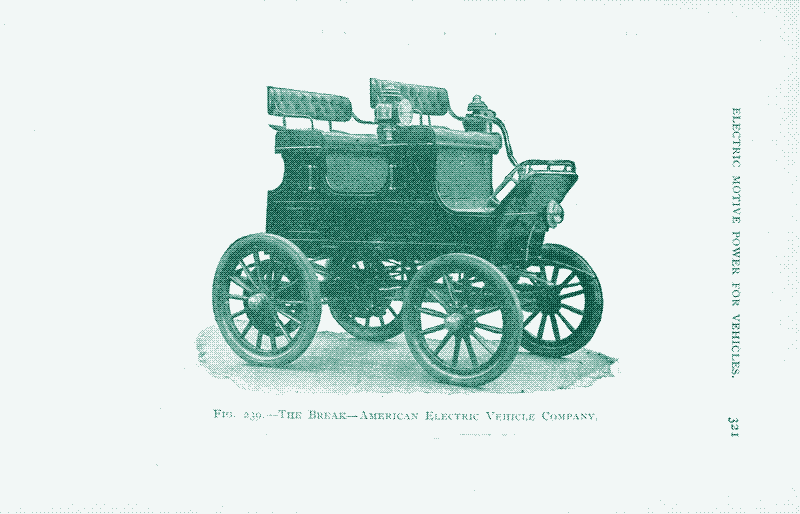
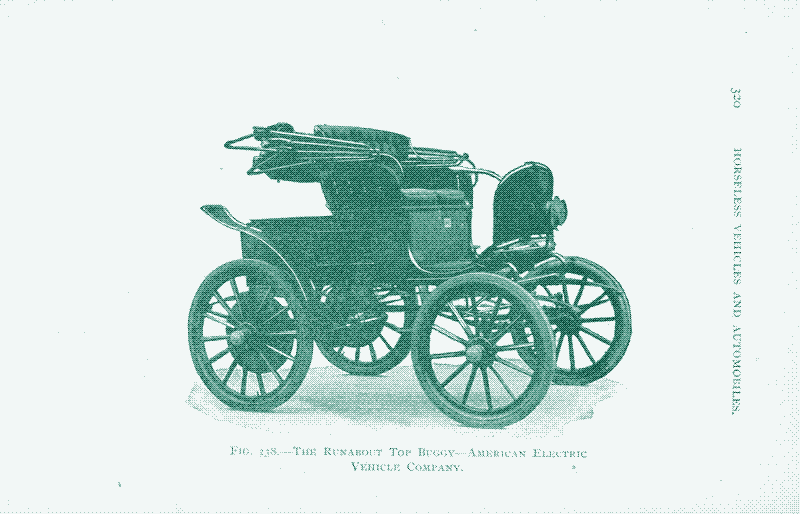
- Runabout top buggy 2 places : 2,5 ch (chevaux-vapeur).
- Break 4 places : 4 ch.
- Dos-à-dos 4 places : 4 ch.
- Mail Phaeton 4 places : 4 ch.
- Top Surrey 4 places : 4 ch.
- Break 6 places : 5 ch.
- Une seule charge suffit pour parcourir entre 55 et 80 km. Les batteries, composées de 42 accumulateurs, peuvent être rechargées dans le véhicule, en 3 heures environ, et s’éteignent automatiquement lorsqu’elles sont pleines. La vitesse de pointe dépend du véhicule, allant de 19,5 à 24 km/h. (images).
Véhicules Waverly Electric Motor de la Indiana Bicycle Company, Indianapolis (Indiana, États-Unis)
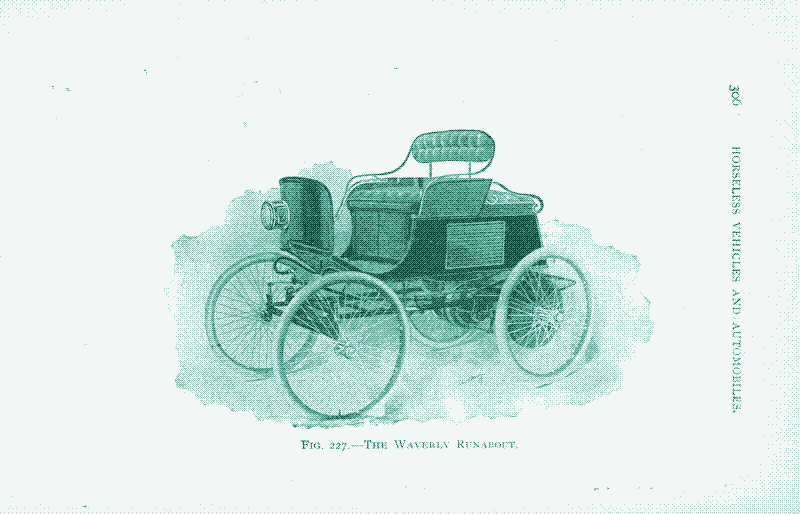
Trois moteurs de puissance différente sont disponibles selon le poids du véhicule : 1,5 ch pour le Runabout, 2,5 ch pour le Phaeton et le Stanhope, et 3,5 ch pour le Delivery wagon. Les batteries, composées de 44 cellules, ont une capacité variable entre 60 et 125 ampères. La plus légère ne pèse que 4 kg par cellule. La vitesse de pointe est de 22,5 km/h. Le Runabout (source et image) est conçu pour 2 personnes, mais il dispose d’une banquette supplémentaire de 2 places. Il pèse 544 kg et possède une autonomie de 56 km.
Avec une autonomie de 65 km et une vitesse de pointe de 22,5 km/h, le Phaeton et le Stanhope (source et image) sont des véhicules très pratiques pour le tourisme et les médecins. Ce fabriquant construit aussi des broughams, dotés d’un moteur de 3,5 ch et d’une batterie de 44 cellules. Ce modèle est équipé de sièges arrières amovibles et d’un chauffage électrique pour l’hiver. Le Waverly merchandise delivery wagon est un véhicule plus robuste que les autres, muni d’un moteur de 3,5 ch et d’une batterie de 44 cellules. La vitesse de pointe atteint les 19,31 km/h. (source et image).
160 kilomètres en Roadster électrique
La question de la place du véhicule électrique dans le marché automobile a suscité de vives discussions entre les premiers constructeurs et les fabricants de batteries. Certains n’étaient pas d’accord pour les présenter comme une solution de transport urbain à courte distance. Selon eux, les mettre sur le marché en tant que véhicules de tourisme était une erreur puisqu’ils souffriraient de la comparaison avec les voitures à essence dotées d’une meilleure autonomie.
« Electrical World » écrit en 1909 : « Comparé aux voitures d’il y a dix ans, les véhicules électriques actuels ont une autonomie sur une charge bien plus élevée, dépassant largement les besoins de transport ordinaires liés aux trajets professionnels ou récréatifs, sauf dans le cas de longs voyages ».
« Je pense que pour la plupart des voitures, la distance moyenne parcourue chaque jour ne dépasse pas 48 km », déclare l’ingénieur germano-américain Charles Proteus Steinmetz au New York Times en 1915. Bien qu’ayant mis au point un nouveau moteur plus efficace pour le Dey Electric Roadster de 1917, Steinmetz n’a pas profité de sa création pour concevoir des véhicules dotés d’une plus grande autonomie. Au lieu de cela, il a préféré concevoir un véhicule moins cher et plus léger (636 kg) : « Le moteur en série consomme 20 % de plus que le moteur à commande. À autonomie équivalente, cela signifie que le poids de la batterie est réduit de 20 %, ce qui permet de moins consommer, d’autant plus qu’elle représente une partie non négligeable du poids total de la voiture. ». (Sources : 1 / 2 / 3).